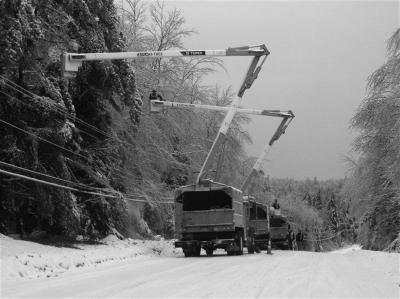 EVERY YEAR, Eastern Maine Electric Co-op must strike a balance between maintaining quality electric service and preserving natural scenery. Eastern Maine’s beautiful and abundant trees, which draw people to this area each year by the thousands, can also interfere with the kind of reliable, quality electric service our customers deserve.
EVERY YEAR, Eastern Maine Electric Co-op must strike a balance between maintaining quality electric service and preserving natural scenery. Eastern Maine’s beautiful and abundant trees, which draw people to this area each year by the thousands, can also interfere with the kind of reliable, quality electric service our customers deserve.
All electric utilities must trim and clear trees and plants in line rights of way. If this work is not done, trees will brush the lines during windstorms, causing momentary power blinks. During worse storms, tree branches and fallen trees can land on the lines and put out power until the trees are removed by linemen. Eastern Maine Electric has these considerations in mind when maintaining the right of way.
For electric utilities, “right of way” refers to a specified width of land under and surrounding the power lines and poles. It is the legal path of the lines. The path widths vary from thirty feet to 150 feet depending on the type of overhead line.
The most labor-intensive right of way maintenance is clearing and trimming, which is performed with the help of bucket trucks, skidders, chippers, chainsaws, and hand-held tools. The Co-op contracts out this work to companies specially licensed in Maine to do this type of work.
Trimming and clearing efforts focus on trees close to or directly beneath the lines. Tall evergreens and hardwoods are cleared, unless they are in cultivated yards, where they are trimmed only as much as necessary to protect the power lines.
In remote areas, trees and shrubs are cleared to the ground. Even low growing bushes and cultivated plants are often cleared, because they will limit access by vehicles to the right of way. Some exceptions are made in more populated areas.
Click here to download clearing guidelines used by Eastern Maine Electric Co-op.
In some areas, it is necessary to use herbicides to prevent rapid regrowth of trees. Ultimately, clearing work is intended to last seven to ten years. Hardwood shoots that spring from stumps, however, can grow fast enough to interfere with the lines in five years or less.
Treating the stumps of cleared trees with herbicides will prevent this rapid regrowth. It will also cut down on the amount of work which will be necessary in the next clearing cycle.
The Cooperative uses only Maine-licensed contractors, and the herbicides used are approved for these purposes by state and federal regulators.
Objective measures of toxicity indicate that the impact on animals from herbicide spraying is minimal. Sprays used by EMEC contractors have less impact on animals than the gasoline engines of the chainsaws and motorized equipment used to do the trimming and clearing.
In fact, the herbicides most used have lower toxicity rates to animals than aspirin.
The Co-op does its utmost to keep the right of way clear so that we may provide the most reliable service to our consumers. A regular program of trimming, clearing, and spraying are required, but EMEC is committed to maintaining service quality without spoiling the beauty that makes Eastern Maine so memorable.

